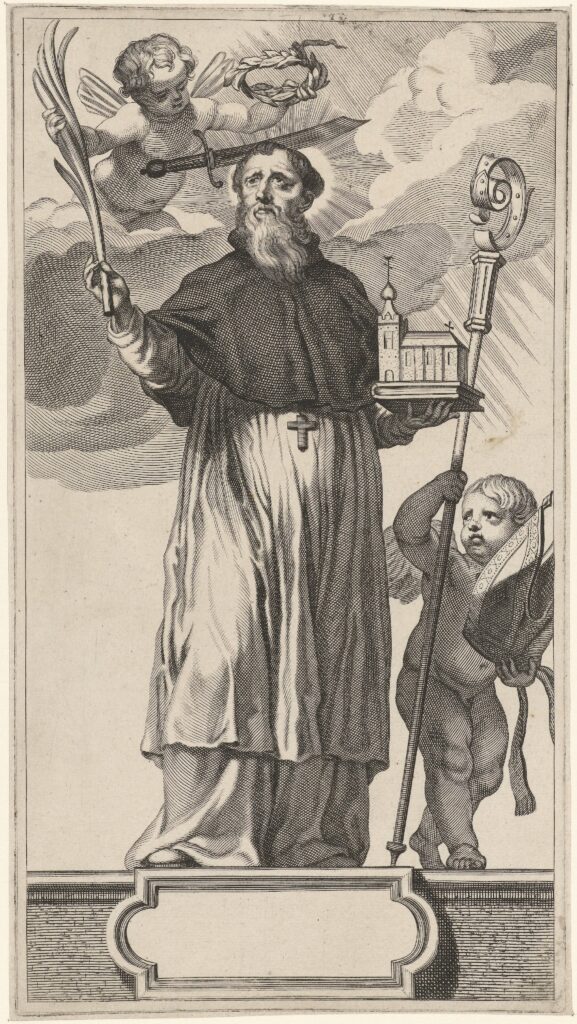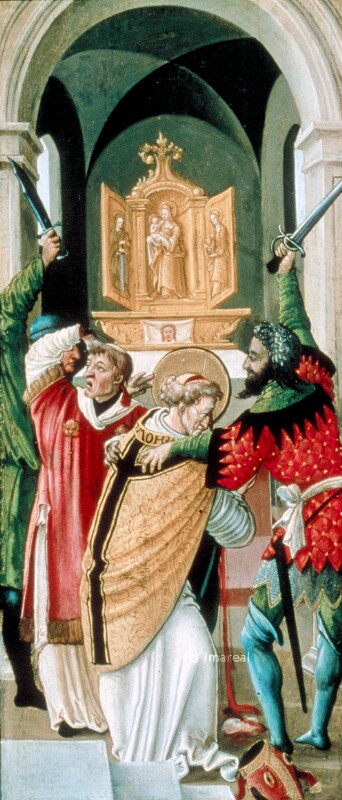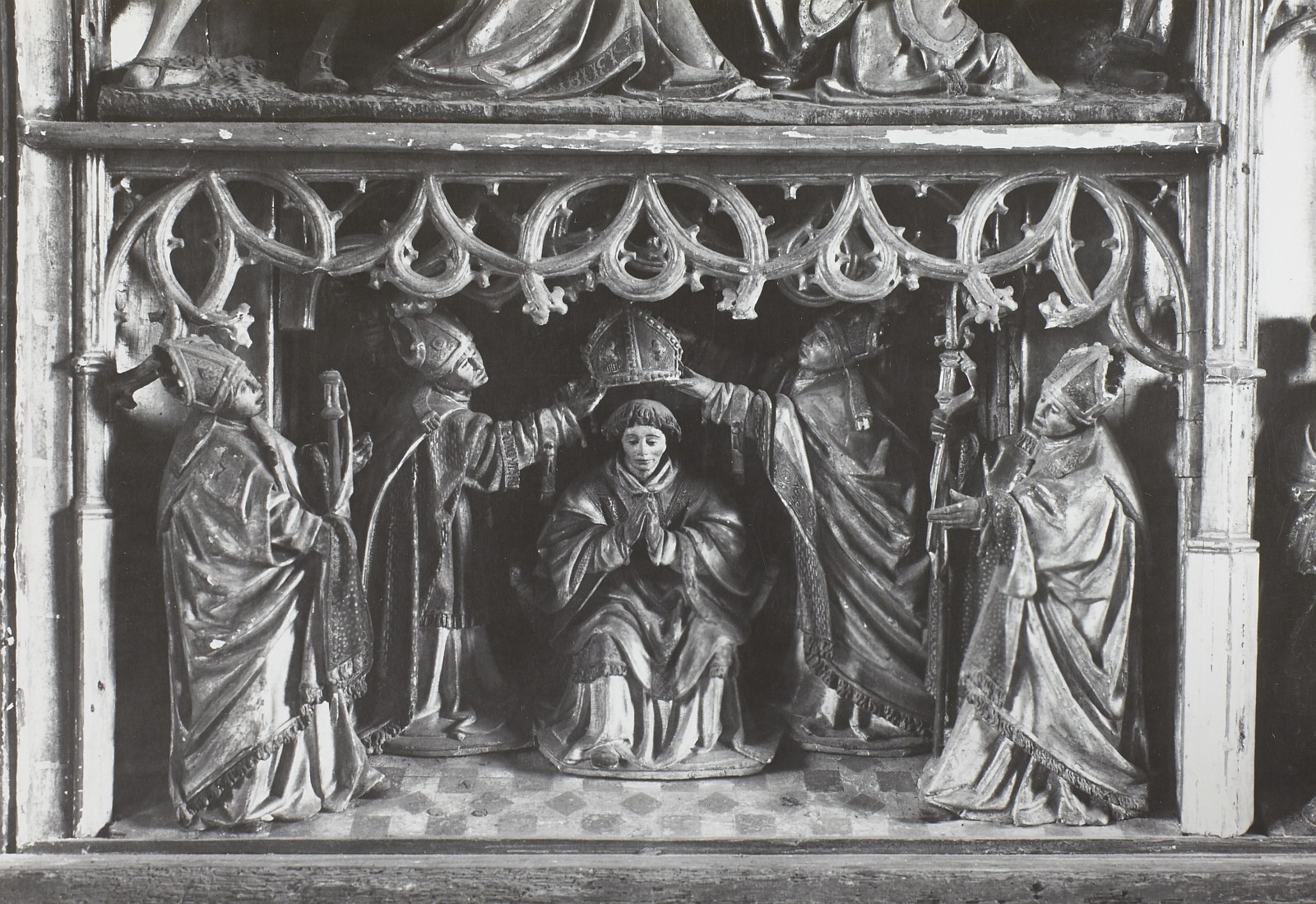Life Details
Born: December 21st, 1118, London, England
Died: December 29th, 1170, Canterbury, Kent
Feast day: December 29th
Patron saint of secular clergy
Background
Every age has its share of charismatic, wealthy, powerful, and influential men. London in the Middle Ages had one of these guys, Saint Thomas Becket.

Theodor Matham, 1615 – 1676
Thomas was born to affluent parents in London. Some sources suggest that his father held local office, such as sheriff of London, while others suggest that he was a merchant. Regardless of his position, Thomas’ parents were able to afford him a comfortable upbringing. He studied at the local Augustinian Merton Priory. Young men from the upper middle or noble classes often received education in medieval Europe. Though Thomas was not a noble, this is where he first likely learned the social norms of the English nobility and became associated with them. Later in his early life, he also studied at the University of Paris. One could look at Thomas’ life and think of him as an academic; however, he also had a passion for field sports, which included falconry and hunting. These activities illustrate his youth and athleticism, which dismiss the notion that he must have always had his nose stuck behind books.
A Strong Intellect and Sense of Responsibility
Around the time he returned from his studies in Paris, Thomas initiated his professional career. His line of specialty seems to be that of an administrator. His first job was to be a clerk in the sheriff’s court. This required him to be highly skilled in recordkeeping, maintaining court files, tracking land transactions, and drafting documents such as warrants and notices. His role may also have required him to summarize testimonies and court proceedings. As a clerk, he was likely one of the few people in town who were able to read and write aside from the clergy. There is no question that Thomas must have had a strong sense of duty because he appeared to thrive on any professional or intellectual challenge that was presented to him.
Because of his talents, he caught the attention of Theobald, the archbishop of Canterbury, who gave him employment under his office. This is likely what launched his career in the church. Archbishop Theobald sent Thomas to study law for a year so that he could further assist with civil and religious matters. After completing his education, Theobald ordained him as a deacon and later as an archdeacon of Canterbury. This role entrusted Thomas with greater responsibilities, including consulting on political and ecclesiastical matters. He often served as a diplomat for Archbishop Theobald with the pope and the English crown. This experience helped prepare him for his subsequent position as Chancellor of England and later Archbishop of Canterbury.
Relationship to King Henry II
It was in Thomas’ role as archdeacon that he facilitated the coronation of King Henry II. Shortly thereafter, Archbishop Theobald recommended Thomas as the king’s new chancellor. This was a role that Thomas eagerly accepted, just as he had done with his previous appointments. Accounts of their relationship suggest that Thomas and Henry II were either best friends or really like brothers. Outside of his professional role as chancellor, they often spent their leisure time hunting or hosting parties for the English nobility. These experiences likely strengthened their relationship through shared time enjoying sport, fine dining, drink, and conversation. Even though they had an age gap of over a decade, one could say that they were inseparable. King Henry II trusted Thomas during his appointment as chancellor with matters of the military and diplomacy. Due to his assiduous work ethic, Thomas became a valuable resource to the king and the kingdom.
Conversion
“Will no one rid me of this turbulent priest?”- King Henry II
In 1162, the position for the Archbishop of Canterbury became available. In medieval times, monarchs had the ability to appoint Catholic bishops, a practice called “lay investiture,” which allowed them to maintain a level of influence in their local diocese. However, the pope had to approve of these appointments for them to be valid. King Henry II found it beneficial to place Thomas in the position of archbishop. He believed that appointing his friend as archbishop would be a sure way to influence the church in England in ways that would benefit him. He also wanted Thomas to continue his position as Chancellor so he could administrate matters in the church and civilly.
But this plan backfired for the king. Thomas accepted the role as archbishop. Additionally, he appeared to undergo a dramatic conversion at the same time, which was most likely sparked by the Holy Spirit and his own intense sense of accountability. Thomas could have easily become what many criticize the later Renaissance popes for, which includes living lives contrary to their roles. Many of them indulged in luxury, engaged in sexual activities, and created scandals. Thomas, on the other hand, took his vows of poverty and chastity and his role as a religious leader seriously. Therefore, he renounced his position as chancellor in order to focus more on his role as archbishop. While he used to use his money and power for himself, he became known for being a strong spiritual leader and giving to the poor.
His conversion sowed discord between King Henry II and himself. In matters between the church and state, he took the church’s position. This became troublesome for King Henry II, and the issues between the two former friends peaked with a series of disputes called the Constitutions of Clarendon. Henry II attempted to limit the pope’s and the Catholic Church’s influence in England. In the end, accepting the discussed stipulations would limit the church’s spiritual authority. Thomas refused to accept them, which led Henry II to take him to court. To avoid punishment, Thomas fled and self-exiled to France from 1164 to 1170.
Eventually, Thomas and Henry II seemed to make amends after the pope’s intervention. During a private conversation in 1170, the pope assured Thomas that he could safely return to England. But right before this conversation, Henry II had completed an illegitimate coronation of his son by one of Thomas’s rivals, the Archbishop of York. In his final act against the king, Thomas excommunicated the Archbishop of York and two other bishops. In their fury, they told King Henry II about the excommunication.
In his rage, the king may have said, “Will no one rid me of this turbulent priest?” The legitimacy of this statement is disputed. However, one biographer of the time writes that the king did say, “What miserable drones and traitors have I nurtured and promoted in my household who let their lord be treated with such shameful contempt by a low-born clerk!” Either way, we can agree that the king was not happy.
Martyrdom and Aftermath

It is unknown if the king ordered the assassination of Thomas. However, four knights seemed to take his complaints seriously. Shortly after his outburst, these knights arrived at the Canterbury Cathedral to find Archbishop Becket and arrest him. When he refused to go with them, the knights drew their swords and violently descended on him. His famous last words were, “For the name of Jesus and the protection of the Church, I am ready to embrace death.” The knights struck Thomas in the head, cutting him open. Eyewitness accounts state that his brain matter spilled onto the floor of the church and that he received a blow to the head with so much force that that sword shattered. Thomas Becket died on the spot.Only three years after Thomas’s passing, the pope declared him a martyr saint because his death had such an impact both in England and abroad. The site of his murder became a popular destination for pilgrims seeking healing and miracles.
The aftermath of the murder did not go so well for the king or the four knights involved. Pope Alexander III excommunicated all four knights. Additionally, King Henry II faced significant backlash from the people and the church for his involvement in Becket’s death. This led to public penance. The king was forced to walk barefoot on the streets of Canterbury and also receive scourging by monks at Becket’s funeral.
Legacy
Today, St. Thomas Becket’s story is seen as a model of standing up for religious principles and defending the church against the power of government control. In 2020, the president of the United States made a proclamation to invite people to celebrate December 29th in honor of the martyrdom of St. Thomas Becket, highlighting religious liberty. St. Thomas Becket’s story has also been recreated or discussed in popular media. In literature, Geoffrey Chaucer’s The Canterbury Tales features pilgrims heading to Canterbury Cathedral, where they visit the shrine of St. Thomas Becket. T.S. Eliot wrote a dramatic play, Murder in the Cathedral, focusing on the events leading up to St. Thomas Becket’s martyrdom. His story has also been featured in theatre and film. There is a Paramount Pictures film called Becket (1964), which can be found on Youtube.
For the Modern Catholic
There are many things to gather from the life and legacy of St. Thomas Becket. But there are a few big ones. St. Thomas is a prime example of someone whose work sanctified them. As someone who seemingly had a type A personality. He seemed to be ambitious and excel at whatever job he was responsible for. We can infer this through his various promotions. When he assumed the position of archbishop, he became aware of the weight of spiritual responsibility that God and the church expected of him. The notion that our work can sanctify us is not new. We actually have a prayer to St. Joseph that requests his intercession that this may be a virtue we develop. Another important aspect to consider is St. Thomas Becket’s example as a champion for defending the church from government persecution and religious freedom. His dedication to his faith and willingness to stand up for what he believed in, even in the face of danger, is a powerful reminder of the importance of staying true to one’s convictions. St. Thomas Becket, pray for us!
